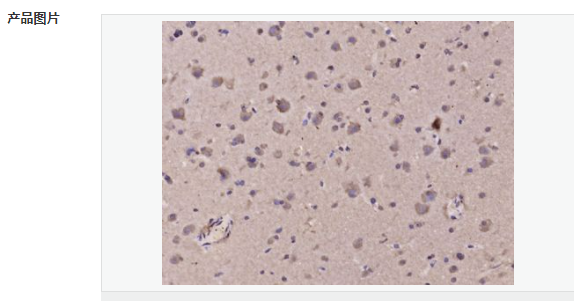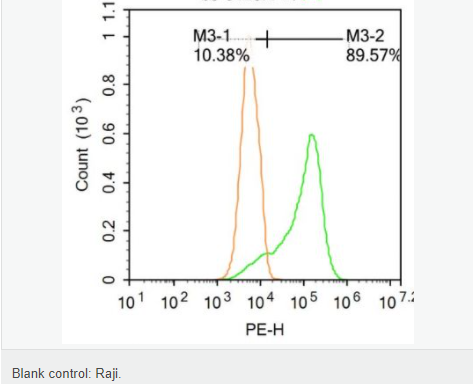
货号
产品规格
售价
备注
BN41941R-50ul
50ul
¥1486.00
交叉反应:Mouse,Human(predicted:Cow,Pig,Dog,Chicken,Rat) 推荐应用:IHC-P,ICC,Flow-Cyt,ELISA
BN41941R-100ul
100ul
¥2360.00
交叉反应:Mouse,Human(predicted:Cow,Pig,Dog,Chicken,Rat) 推荐应用:IHC-P,ICC,Flow-Cyt,ELISA
BN41941R-200ul
200ul
¥3490.00
交叉反应:Mouse,Human(predicted:Cow,Pig,Dog,Chicken,Rat) 推荐应用:IHC-P,ICC,Flow-Cyt,ELISA
| 英文名称 | TRP12/TRPV4 |
| 中文名称 | 瞬时受体电位蛋白12抗体 |
| 别 名 | osm-9-like TRP channel 4; OTRPC 4; OTRPC4; Transient receptor potential cation channel subfamily V member 4; Transient receptor potential protein 12; TRP 12; TRP12; TRPV 4; Vanilloid receptor-like channel 2; Vanilloid receptor-like protein 2; Vanilloid receptor-related osmotically-activated channel; VR 4; VR OAC; VR4; VRL 2; VRL2; VROAC. |
| 研究领域 | 肿瘤 细胞生物 免疫学 微生物学 信号转导 通道蛋白 表观遗传学 |
| 抗体来源 | Rabbit |
| 克隆类型 | Polyclonal |
| 交叉反应 | Human, (predicted: Mouse, Rat, Chicken, Dog, Pig, Cow, ) |
| 产品应用 | ELISA=1:5000-10000 IHC-P=1:100-500 Flow-Cyt=1ug/test (石蜡切片需做抗原修复) not yet tested in other applications. optimal dilutions/concentrations should be determined by the end user. |
| 分 子 量 | 96kDa |
| 细胞定位 | 细胞浆 细胞膜 |
| 性 状 | Liquid |
| 浓 度 | 1mg/ml |
| 免 疫 原 | KLH conjugated synthetic peptide derived from human TRPV4:301-400/871 |
| 亚 型 | IgG |
| 纯化方法 | affinity purified by Protein A |
| 储 存 液 | 0.01M TBS(pH7.4) with 1% BSA, 0.03% Proclin300 and 50% Glycerol. |
| 保存条件 | Shipped at 4℃. Store at -20 °C for one year. Avoid repeated freeze/thaw cycles. |
| PubMed | PubMed |
| 产品介绍 | The detection of noxious stimuli (chemical, mechanical, or thermal) occurs predominantly at the peripheral terminals of primary afferent neurons. This information is ultimately transmitted to the central nervous system to evoke appropriate protective reflexes. TRPV4 is a non selective calcium permeant, swell activated, cation channel probably involved in osmotic and mechano sensitivity. Activation by exposure to hypotonicity within the physiological range, low pH, citrate and phorbol esters exhibits an outward rectification. Once activated the channel seems to be regulated in a calmodulin dependent manner, with a negative feedback mechanism. Function: Non-selective calcium permeant cation channel probably involved in osmotic sensitivity and mechanosensitivity. Activation by exposure to hypotonicity within the physiological range exhibits an outward rectification. Also activated by low pH, citrate and phorbol esters. Increase of intracellular Ca(2+) potentiates currents. Channel activity seems to be regulated by a calmodulin-dependent mechanism with a negative feedback mechanism. Promotes cell-cell junction formation in skin keratinocytes and plays an important role in the formation and/or maintenance of functional intercellular barriers. Acts as a regulator of intracellular Ca(2+) in synoviocytes. Plays an obligatory role as a molecular component in the nonselective cation channel activation induced by 4-alpha-phorbol 12,13-didecanoate and hypotonic stimulation in synoviocytes and also regulates production of IL-8. Subunit: Homotetramer (Probable). Self-associates in a isoform-specific manner. Isoforms 1/A and 5/D but not isoform 2/B, 4/C and 6/E can oligomerize. Interacts with calmodulin. Interacts with Map7 and Src family Tyr protein kinases LYN, SRC, FYN, HCK, LCK and YES. Interacts with CTNNB1. The TRPV4 and CTNNB1 complex can interact with CDH1. Part of a complex containing MLC1, AQP4, HEPACAM and ATP1B1. Subcellular Location: Cell membrane; Multi-pass membrane protein. Cell junction, adherens junction. Note=Assembly of the putative homotetramer occurs primarily in the endoplasmic reticulum. Isoform 1: Cell membrane. Isoform 5: Cell membrane. Tissue Specificity: Found in the synoviocytes from patients with (RA) and without (CTR) rheumatoid arthritis (at protein level). Post-translational modifications: Phosphorylation results in enhancement of its channel function. DISEASE: Defects in TRPV4 are the cause of brachyolmia type 3 (BRAC3) [MIM:113500]; also known as brachyrachia. The brachyolmias constitute a clinically and genetically heterogeneous group of skeletal dysplasias characterized by a short trunk, scoliosis and mild short stature. BRAC3 is an autosomal dominant form with severe kyphoscoliosis and flattened, irregular cervical vertebrae. Defects in TRPV4 are the cause of spondylometaphyseal dysplasia Kozlowski type (SMDK) [MIM:184252]. The spondylometaphyseal dysplasias (SMDs) are a group of short-stature disorders distinguished by abnormalities in the vertebrae and the metaphyses of the tubular bones. SMDK is an autosomal dominant disorder characterized by significant scoliosis and mild metaphyseal abnormalities in the pelvis. The vertebrae exhibit platyspondyly and overfaced pedicles. Similarity: Belongs to the transient receptor (TC 1.A.4) family. TrpV subfamily. TRPV4 sub-subfamily. Contains 3 ANK repeats. SWISS: Q9HBA0 Gene ID: 59341 Database links: Entrez Gene: 59341 Human Entrez Gene: 63873 Mouse Omim: 605427 Human SwissProt: Q9HBA0 Human SwissProt: Q9EPK8 Mouse Unigene: 506713 Human Unigene: 266450 Mouse Unigene: 64508 Rat Important Note: This product as supplied is intended for research use only, not for use in human, therapeutic or diagnostic applications |

